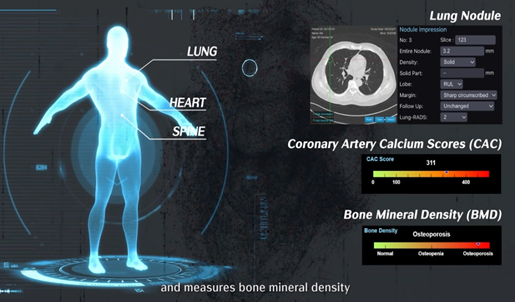Introduction
The DeepLung-CAC AI Screening Platform is an AI-powered software designed for chest area screening, covering both the lungs and heart. Using deep learning analysis of low-dose chest CT (LDCT) images, it aids in detecting lung nodules and predicting and classifying coronary artery calcification (CAC) risk. The platform includes a one-click automated structured report generation system, with a professional report format tailored for use in hospitals, enabling radiologists to preview, edit, and confirm screening results.
Features / strengths
■Lung Nodule Detection: The DeepLung module uses deep learning technology, trained on a large CT image dataset, to quickly detect lung nodules. Detection is completed in 3-5 minutes and adheres to international Lung RADS standards.
■Coronary Artery Calcification Risk Prediction: Automatically analyzes low-dose chest CT images to assess the severity of coronary artery calcification. The risk model is trained using CT images and Agatston scoring (CAC score).
■Automated Structured Screening Report Generation: Generates reports for early lung cancer detection (based on the National Health Administration’s guidelines) and customizable health reports for hospitals.
■Case Prioritization by Risk Level: Through risk stratification, helps doctors prioritize high-risk patients, enhancing diagnostic accuracy and timeliness, while optimizing case prioritization and resource allocation to improve overall healthcare quality and treatment outcomes.
Specification in detail
■ AI-Powered Pulmonary Nodule Detection:
Accurately identifies suspicious nodules in lung images to support early diagnosis.
■ Coronary Artery Calcification Risk Assessment:
Quantifies calcium scores to aid in cardiovascular risk evaluation.
■ One-Click Structured Report Generation:
Automatically generates standardized reports to enhance clinical efficiency and consistency.
■ High Cross-Platform Compatibility:
Compatible with various operating systems without requiring additional hardware.
■ Multilingual Interface Support:
Built-in English and Chinese interface for seamless use across international clinical settings.


